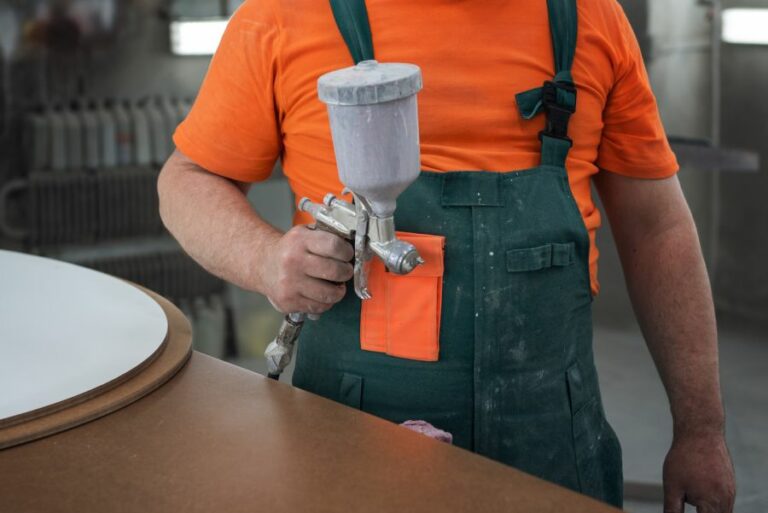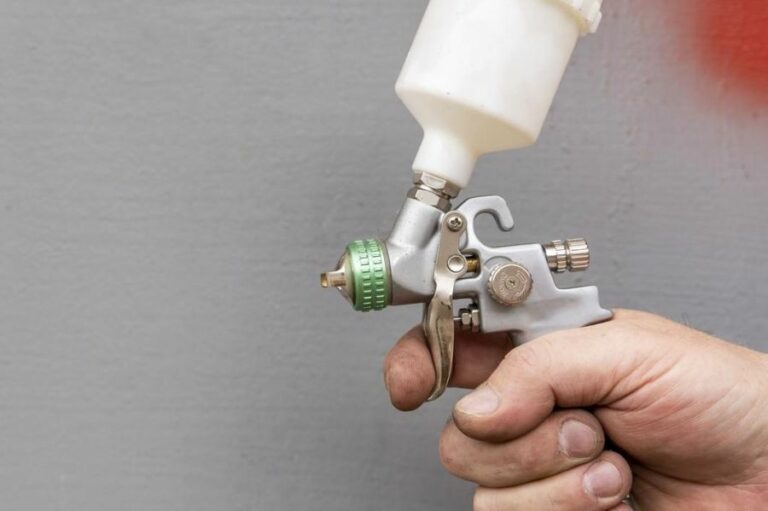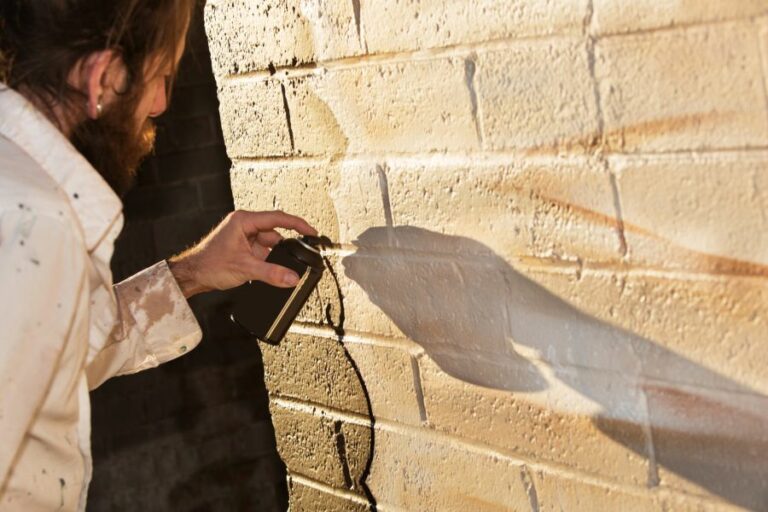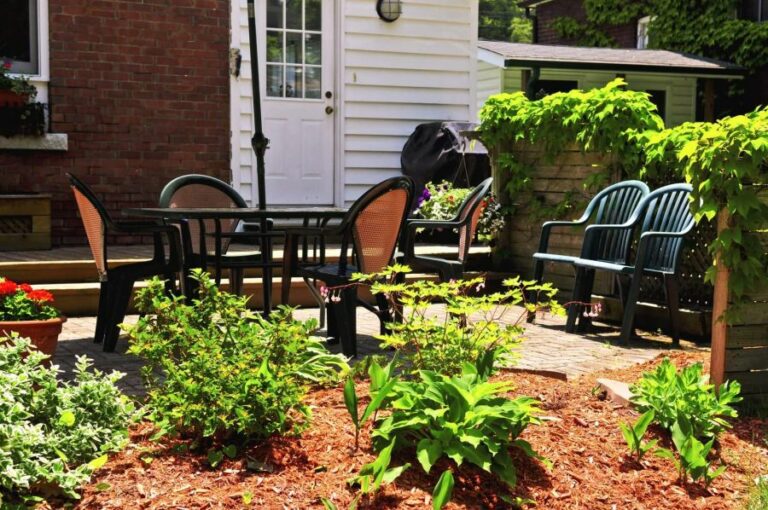DIY Faux Finish Techniques With Spray Paint. What Pros Say
Have you ever considered redecorating your home but felt intimidated by the prices or lack of expertise? Fret not! We’ve covered you with some amazing DIY faux finish techniques using spray paint that completely transform your space. With these nifty tricks in your back pocket, you’ll achieve professional-looking results without breaking the bank or hiring a decorator.
Diy faux finish techniques with spray paint:
DIY faux finish techniques with spray paint include stone, marble, metallic, and wood grain finishes. Key steps involve choosing high-quality spray paint, applying a base coat, creating desired patterns using tools like sponges, brushes, or wood grain tools, and sealing the surface with a clear topcoat for protection and enhanced appearance.

Discover the magic of transforming plain surfaces with DIY faux finish techniques using spray paint. Unleash your creativity and elevate your home’s aesthetics with our expert tips and tricks. Don’t miss out. Read on for endless design possibilities!
Contents
- 1 Spray Paint Faux Finish: DIY Techniques and Tips
- 2 Achieve a Textured Look Using Spray Paint: A Guide
- 3 Creating Faux Paint Finishes: Techniques and Methods
- 4 DIY Faux Glaze: Crafting with Paint and Imagination
- 5 Designing with Spray Paint: Tips for Stunning Creations
Spray Paint Faux Finish: DIY Techniques and Tips
A faux finish can add character and depth to any room, but many people are intimidated by the thought of attempting it themselves. Fear not, because this comprehensive guide will teach you how to create a vast range of faux finish techniques using spray paint.
• Get Prepared
As with any DIY project, preparation is key to success. Lay out your work area with drop cloths or plastic sheeting, and make sure you have adequate ventilation, as spray paint fumes can be harmful if inhaled.
You will also need a variety of spray paint colors, a sponge, newspaper, painter’s tape, and some clean rags.
– Choose the Right Spray Paint
To ensure the best results, it is essential to use high-quality spray paint. I recommend looking for a paint that is specifically designed for faux finishes, such as Valspar Bronze, Rust-Oleum Universal Metallic, or Krylon Fusion All-in-One.
These paints adhere well to a variety of surfaces and provide a durable, long-lasting finish.
– Test Your Technique
Before you start your project, practice your chosen faux finish technique on a disposable surface, like a piece of cardboard or scrap wood. This will give you an idea of how the various paints and techniques will look when applied and allow you to perfect your skills.
• Stone Faux Finish
A stone faux finish gives a modern, earthy look to walls, and it is easier to achieve than you might think.
- Base coat: Choose a base color that will represent the darkest shade in your faux stone finish. Apply this color evenly to the wall using broad, sweeping strokes. Allow the paint to dry completely before proceeding.
- Sponge technique: To create the appearance of stone, use a natural sea sponge to apply a lighter color (or multiple colors) of paint over the base coat. Dip the sponge in the paint, then dab it on a piece of newspaper to remove excess paint before applying it to the wall in a random, irregular pattern. Layer the colors to your liking, and don’t be afraid to experiment.
- Details: To add depth and dimension to the faux stone finish, use small artist brushes and various shades of paint to accentuate the natural inconsistencies present in real stone. Here is a useful guide from the United States Department of the Interior on painting techniques for rock formations.
• Marble Faux Finish
A faux marble finish adds an elegant, luxurious touch to walls, furniture, and more.
- Base coat: Choose a light, neutral color like white, cream, or beige for your base coat. Apply this color evenly to the wall and allow it to dry completely.
- Veining: Using a feather, a thin artist brush, or a small piece of cardboard, create delicate veins with a darker shade of paint. Lightly dip your chosen tool into the paint, remove any excess, and draw thin, random lines across the surface. Allow the lines to crisscross and intersect, and vary the pressure applied to create more natural-looking veins.
- Blending: While the veining is still wet, use a clean, dry brush to gently blend the lines, softening the appearance and mimicking the look of real marble. Work quickly, as the paint will dry and become more difficult to blend.
- Sealing: Once the marble faux finish is completely dry, I recommend sealing it with a clear topcoat to protect the surface and enhance the glossy, polished look of real marble.
• Metallic Faux Finish
A metallic faux finish adds a touch of glamour to any space, making it perfect for accent walls or features.
- Base coat: Choose a base color that will complement the metallic color you plan to use. Apply this color evenly to the wall and allow it to dry completely.
- Metallic layer: For best results, use a metallic spray paint specifically designed for faux finishes. Starting at the top of the wall, apply the metallic paint using light, sweeping movements, and allow it to gently mist down over the base color. Layer the metallic color until you achieve your desired effect.
- Texturing: For added dimension, use a crumpled piece of newspaper or a sponge to blot the wet metallic paint, revealing the base color underneath and creating an interesting texture.
- Sealing: After the metallic faux finish has dried, seal it with a clear topcoat to protect the surface and maintain the metallic sheen.
• Wood Grain Faux Finish
Achieving a realistic wood grain finish with spray paint is easier than you might think.
- Base coat: Choose a light or medium shade of brown for your base coat. Apply this color evenly to the wall, and allow it to dry completely.
- Wood grain: Purchase a wood grain tool, which is available at most hardware or craft stores. Using a darker shade of brown, apply the paint to the wood grain tool, then drag it across the base coat, rocking it back and forth slightly to create an authentic wood grain pattern. Reapply the paint as needed.
- Knots: To add character and realism to your faux wood finish, create knots in the wood grain by painting a small, irregularly shaped circle of darker brown. Use a clean, dry brush to blend the edges, giving the appearance of a natural knot in the wood.
- Sealing: Once the wood grain faux finish is dry, seal it with a clear topcoat to protect the surface and enhance the look of the finish.
With these easy-to-follow techniques and a little patience, you’ll be able to create stunning faux finish effects with spray paint in no time. Happy painting!
Achieve a Textured Look Using Spray Paint: A Guide
Achieving a textured look with spray paint is a creative and simple technique that can transform the appearance of objects, walls, or furniture. This style adds depth and dimension to surfaces, resulting in a professional and aesthetically pleasing finish.
• Preparing Your Surface
Before you begin, it is crucial to prepare the surface you’ll be working on. Clean the surface by removing dirt, dust, and any existing paint. In some cases, it may be necessary to sand the surface, particularly when working with wood or metal.
This will help the spray paint adhere effectively and enhance the texture. Always ensure that the area in which you’ll be spraying is well-ventilated, and wear proper safety gear, such as gloves and a mask.
• Selecting the Right Spray Paint
To achieve the desired textured finish, it is essential to choose a spray paint explicitly designed for such purposes. Textured spray paints come in various finishes, such as stone, sand, rust, and more.
These products contain additives and thicker resins, which create the texture upon application. You can also experiment with regular spray paints and specific techniques to obtain unique textures.
• Techniques for Creating Texture with Spray Paint
– Stippling Method
Stippling is a technique in which you dab the paint onto the surface rather than spraying it in a continuous motion. You can use a sponge, cloth, or a paintbrush for stippling.
First, apply a base coat of spray paint and let it dry. Then, spray some paint onto your chosen applicator and dab it onto the surface. This technique allows for various textures depending on your applicator and the pressure applied.
– Adding Fillers
Adding fillers to spray paint is an innovative way to achieve a textured look. Sand, small stones, sawdust, or even grains can be mixed with the paint to create interesting textures.
Mix the filler with the spray paint in a separate container and then apply it to the surface using a brush or sponge. This method is particularly useful for those seeking an earthy, organic texture.
– Layering Technique
The layering technique involves applying multiple layers of paint on the surface, which can be achieved by targeting certain areas or using different colors. Apply the first layer of paint and let it dry before applying the second.
The drying time between layers can vary, leading to unique textures. Experiment with different layering patterns and colors to achieve the desired effect.
– Sgraffito Technique
The sgraffito technique requires a base layer of paint, followed by an application of a contrasting color.
Once the second color is applied, utilize a scraping tool or a brush to partially remove the top layer while it is still wet. This will reveal the base color underneath, creating a textured, multi-color appearance.
– Crackle Effect
Achieving a crackle effect with spray paint involves using a crackle medium or applying a layer of glue between two layers of paint. Apply the base coat of paint and let it dry.
Then, apply a crackle medium or glue, and let it partially dry. Finally, apply the top layer of paint. As the glue dries, it will create a crackled texture.
• Tips for Successful Textured Spray Painting
- Always practice your chosen technique on a scrap piece of material before working on your final project. This will help you become familiar with the process and allow room for experimentation.
- Hold the spray paint can at a consistent distance from the surface to ensure even application. Spray paint manufacturers typically recommend a distance of 10-12 inches.
- Avoid spraying continuously in one area, as this may lead to dripping or an uneven texture. Use a sweeping motion from side to side, slightly overlapping each pass.
- Follow the instructions provided by the spray paint manufacturer and allow sufficient drying time between coats.
- Apply a clear sealant, if desired, to protect the textured paint from wear and tear, especially in high-traffic or outdoor areas.
• Conclusion
Textured spray paint offers endless opportunities to add depth, dimension, and creativity to surfaces.
By utilizing proper preparation techniques, selecting the right paint, and experimenting with different methods, you can successfully achieve a textured look that enhances the aesthetic appeal of your projects.
For further information and inspiration, consider visiting art-specific websites like The National Gallery of Art or seek out online tutorials from experienced artists.
Step | Description |
|---|---|
1 | Choose the right spray paint. Pick a paint that’s specifically designed for creating textured finishes. |
2 | Prepare the surface. Clean the surface you want to paint and make sure it’s free from dirt, grease, and oil. Lightly sand the surface if needed. |
3 | Apply a primer. To ensure proper adhesion and a smoother finish, apply a primer suitable for your surface. |
4 | Shake the can well. Before applying the paint, shake the spray can vigorously for at least a minute to mix the paint properly. |
5 | Apply the textured spray paint. Hold the can 10-12 inches away from the surface and use a sweeping motion. Apply multiple light coats, allowing the paint to dry between each coat. The more coats you apply, the more texture you’ll create. |
6 | Let the paint dry. Allow the textured spray paint to dry according to the manufacturer’s instructions. Some paints may require up to 24 hours to dry completely. |
7 | Apply a clear coat (optional). If you want to protect the texture and make it more durable, apply a clear coat after the paint has fully dried. |
Creating Faux Paint Finishes: Techniques and Methods
In the world of interior design, faux paint finishes have become increasingly popular due to their versatility and ability to mimic high-end materials such as marble, wood, and stone.
Faux finishes are an excellent option for homeowners looking to elevate their space without committing to a costly renovation. This comprehensive guide will detail various techniques, tips, and tricks for achieving a stunning faux paint finish.
• Selecting the Right Tools
To achieve a professional-grade faux paint finish, it’s crucial to select the right tools for the job. Essential items include:
- High-quality paint brushes, rollers, and sponges
- Paint trays and liners
- Painter’s tape
- Drop cloths or plastic sheeting
- Stir sticks
- Ladder or step stool
While these may seem obvious, it’s worth investing in high-quality tools to ensure a more polished result.
• Basic Techniques for Faux Painting
There are several basic techniques used in the creation of faux paint finishes. Familiarizing yourself with these methods will not only help you create diverse effects but also provide inspiration for your paint projects.
– Glazing
Glazing is a technique that involves the application of a thin, transparent layer of color over an existing painted surface. This creates depth and variation in color.
Begin by mixing a glaze into a chosen paint color (usually consisting of 1 part paint to 4 parts glaze), then apply the mixture evenly to the surface using a brush or roller.
– Ragging and Bagging
These two techniques involve applying paint to a surface and then removing some of it with a textured material such as a rag or plastic bag. Doing this creates a textured, mottled effect that can emulate materials like stone, leather, or parchment.
Simply apply the paint using a brush or roller, then immediately press and lift the rag or bag against the surface to remove a portion of the paint in a random pattern.
– Sponging
Sponging is a technique that works well for creating a rough stone-like texture. Using a natural sea sponge, dip it into the paint and dab it onto the surface, varying the pressure and angle for a more random effect.
For a more subtle look, the sponge can also be used to remove paint, similar to the ragging method.
– Color Washing
Color washing is the application of a thin, diluted paint mixture to a surface in a loose, swirling motion creating a soft, subtle finish reminiscent of aged plaster.
To achieve this look, mix equal parts of paint and water or a glazing medium, then apply using a large soft-bristled brush, working the brush in circular, overlapping strokes.
– Dry Brushing and Dragging
These two techniques are useful for creating a wood grain or striated appearance. For dry brushing, use a stiff-bristled brush with minimal paint and drag it across the surface, using long, even strokes.
Dragging, on the other hand, involves applying a uniform layer of paint first, then pulling a tool such as a brush, comb, or graining rocker through the wet paint to create lines and grooves.
• Expert Tips and Tricks
- Experiment first: Before diving into a complete faux paint finish on a large surface, practice on a small, inconspicuous space or a piece of poster board to hone your skills and see how the paint reacts.
- Work in sections: When working on larger surfaces, it helps to break the area up into smaller, manageable sections to ensure the paint application and texturing remain consistent throughout.
- Keep the room temperature consistent: Variations in temperature and humidity can affect the drying time and appearance of your paint finish, so try to maintain a consistent environment during your project.
- Mix enough paint: Ensure you mix enough paint and glazing medium to complete your project without needing to remix, as color discrepancies can occur.
- Clean your tools: Properly cleaning the tools after each use will lead to better paint application and longer-lasting equipment.
In conclusion, mastering faux paint finishes takes practice, patience, and the right tools for the job. With a range of techniques at your disposal, you’ll be well-equipped to create stunning, unique effects that add character and depth to your space. Happy painting!
Step | Instructions |
|---|---|
1 | Prepare the surface by cleaning and sanding it to ensure a smooth and clean surface. |
2 | Apply a base coat of paint to the surface and allow it to dry completely. |
3 | Choose a faux finish technique (e.g., sponge painting, rag rolling, color washing, etc.) and gather the necessary tools and materials. |
4 | Apply the glaze mixture to the surface using the chosen faux finish technique, working in small sections and blending as you go. |
5 | Allow the faux finish to dry completely before adding any additional layers or details. |
6 | Apply a clear protective finish or sealant, if desired, to protect the faux finish and ensure its longevity. |
DIY Faux Glaze: Crafting with Paint and Imagination
Faux glazing is a popular technique used by homeowners and professionals alike to create unique and decorative finishes on surfaces like walls, ceilings, and furniture.
The technique involves applying thin, transparent layers of paint, sometimes referred to as “glaze,” to create various patterns and textures.
• Choosing the Right Materials
To achieve a successful faux glazing finish, you must start by selecting the appropriate materials for the job. Below are the key elements to consider when gathering your supplies:
– Paint
The base paint you pick will serve as the foundation for your faux glaze. It is important to select high-quality latex or acrylic paint in a low-sheen finish like eggshell or satin. These finishes provide enough gloss to allow the glaze to move and blend without being too shiny.
– Glazing Medium
A crucial component of faux glazing is the glazing medium, which mixes with the paint to create a translucent layer. You can purchase pre-mixed glazing mediums from most paint stores or make your own by diluting latex or acrylic paint with water or a glazing liquid.
– Tools
Depending on the specific faux finish you want to achieve, you will need different tools to apply and manipulate the glaze. Some popular tools include paintbrushes, natural sea sponges, plastic bags, rags, and specialized texture tools.
It’s essential to have a variety of tools on hand to experiment with and find the best one for your desired finish.
• Mixing the Faux Glaze
After selecting the materials, the next step is to mix the faux glaze. Follow the steps below to prepare the glaze:
- Measure your paint: For a standard glaze mixture, you’ll need approximately 1 part paint to 4 parts glazing medium. However, you can adjust this ratio to achieve more transparency or opacity as desired.
- Combine the paint and glazing medium: Slowly pour the glaze medium into your paint, being careful not to introduce air bubbles. Mix the two components gently but thoroughly until you achieve a smooth, uniform consistency.
- Add water or glazing liquid: If your glaze is too thick or opaque, add small amounts of water or glazing liquid to create the desired consistency. Remember that adding too much water can compromise the paint’s adhesion, so proceed cautiously.
- Test your glaze: Before applying the glaze to your entire surface, test it on a small, inconspicuous area to ensure it produces the desired effect. Adjust the glaze mixture and application technique as needed.
• Applying the Faux Glaze
Once your faux glaze is mixed and ready to go, you’re ready to apply it to your surface. Keep in mind that the application technique will vary based on the specific faux finish you’re aiming to achieve. Some popular finishes and their application methods include:
– Color Washing
Color washing involves creating a soft, subtle finish by applying the glaze in a loose, random pattern. Use a large, soft-bristle brush to dab or brush the glaze onto the surface, then use a clean, damp rag to blend and soften the edges.
– Rag Rolling
This technique involves rolling or dabbing a crumpled rag saturated with the glaze onto the surface. The result is a textured, random pattern that adds depth and interest to your walls or furniture.
– Sponging
Similar to rag rolling, sponging involves applying the glaze using a sponge. This creates a more organic, random texture that can be achieved by varying the pressure, sponge size, and pattern of application.
– Stri
Stri is a technique that creates soft, vertical lines or streaks on the surface, reminiscent of fabric or fine brushstrokes. To achieve this finish, use a wide, dry brush to drag the glaze down the surface in vertical strokes, then soften the lines by gently blending with a clean, dry brush.
• Finishing Touches
After applying your faux glaze, it’s essential to add a protective coat, especially for surfaces prone to wear and tear (such as furniture). Choose a compatible sealer, like water-based polyurethane or clear acrylic, and apply a thin, even coat to your surface, following the manufacturer’s instructions.
In conclusion, creating faux glaze with paint is an accessible, versatile technique that can transform your interiors and furnishings with a unique, customized finish. With the right materials, careful preparation, and practice, you can achieve stunning results that add character and depth to your home.
Step | Description |
|---|---|
1 | Gather materials: latex or acrylic paint, glaze (latex or acrylic), paintbrush, paint tray, and a sponge or rag. |
2 | Choose your base paint color and glaze color. The glaze color should be complementary to the base paint color. |
3 | Prepare the surface you want to glaze by cleaning it and applying a primer if necessary. |
4 | Paint the surface with the base paint color and let it dry completely. |
5 | Create the glaze mixture by combining 1 part paint with 4 parts glaze in a paint tray. |
6 | Apply the glaze mixture onto the surface using a paintbrush, working in small sections. |
7 | While the glaze is still wet, use a sponge or rag to dab it, creating the desired faux finish effect. Repeat this process until the entire surface is glazed. |
8 | Allow the glaze to dry completely. If desired, apply a clear protective finish to seal and protect the faux glaze effect. |
Designing with Spray Paint: Tips for Stunning Creations
Creating a stunning design with spray paint can be an incredibly rewarding and fun process.
• Choose the Right Materials
– Selecting the Spray Paint
There are various types of spray paint available, and choosing the right one for your project is essential. Here are some factors to consider when selecting your spray paint:
- Quality: High-quality spray paint will provide better coverage, more durability, and a smoother finish. Look for brands like Montana Gold, Liquitex, or Krylon.
- Color: Choose colors that are vibrant and provide good coverage. Consider your design and the surface you will be working on when selecting your colors.
- Finish: Different finishes available include matte, satin, or glossy. Choose a finish that complements your design style.
– Preparing the Surface
Before you start, it’s crucial to prepare the surface on which you will be painting. This includes:
- Cleaning: Ensure the surface is clean and free of dirt, dust, or grease. Use a mild detergent solution to clean surfaces, and rinse thoroughly with water.
- Sanding: If the surface is rough, sand it gently with medium-grit sandpaper to create a smoother surface for better paint adherence.
- Priming: Apply a coat of primer to the surface to ensure even paint application and longevity.
• Plan Your Design
Before spraying any paint, plan and sketch out your design. You may want to draw or print your design on paper and use it as a reference. When creating your design, consider the following:
- The scale of the design on your surface
- The colors and techniques to be used
- The level of detail required in your design
Remember, the more time you spend planning, the better your final design will be.
• Masking and Stencils
One of the most effective ways to create clean, sharp designs with spray paint is by using masking techniques and stencils.
– Masking
Masking involves covering specific areas of your surface with tape, paper, or other materials to protect them from paint. This allows you to create clean and precise lines or shapes in your design.
Be sure to use high-quality painter’s tape that will not damage the surface or leave behind residue when removed.
– Stencils
Stencils are an excellent tool for creating uniform and intricate designs. You can make your stencils from various materials, like paper, plastic, or vinyl.
Be sure to cut clean, precise edges for the best results. When using stencils, remember to secure them to your surface to prevent any movement while painting.
• Spray Paint Application Techniques
Utilizing different spray paint techniques will help you achieve your desired design results. Here are some common techniques to consider:
– Basic Application
Hold the spray can about six to twelve inches away from the surface, and apply even sweeping motions to apply the paint. Apply multiple thin layers rather than a single, heavy coat to prevent drips and uneven coverage.
– Blending
To blend two or more colors seamlessly, apply the first color to the area you want to blend. While the paint is still wet, apply the second color over the first, using a sweeping motion to overlap the edges. Continue this process until you achieve the desired blend.
– Texturing
Create texture in your design by varying the distance between the spray can and the surface or using household items like sponges, plastic bags, or brushes. Experiment with these materials to achieve unique textures and patterns.
• Safety and Clean-up
Spray paint fumes can be harmful, so be sure to work in a well-ventilated area or outdoors. Wear a mask and protective gear like gloves and goggles to protect yourself from paint particles and fumes.
After completing your design, promptly and carefully remove any masking materials or stencils. Allow the paint to dry fully before touching the surface or adding any additional layers. Clean up any spills and properly dispose of used materials.
In conclusion, by choosing the right materials, planning your design, mastering techniques, and ensuring safety, you can create an impressive design with spray paint. With patience and practice, the possibilities are endless. Happy painting!
Step | Description |
|---|---|
1 | Choose a workspace with proper ventilation and lay down a protective cover to prevent overspray. |
2 | Select a suitable spray paint color and finish for your project. Shake the can for 1-2 minutes before use. |
3 | Create or choose a stencil design for your project. You can use pre-made stencils or make one yourself using paper, plastic, or adhesive vinyl. |
4 | Secure the stencil to your surface using painter’s tape or adhesive spray. Ensure it is flat and smooth to prevent paint from bleeding under the stencil. |
5 | Hold the spray paint can 6-8 inches away from the surface and apply paint using steady, even strokes. Apply a thin coat and let it dry for a few minutes before adding additional coats if needed. |
6 | Once the paint is dry, carefully remove the stencil from the surface. If necessary, use a small brush or cotton swab to touch up any imperfections in the design. |
7 | Allow the finished design to dry completely before handling or displaying the item. |







